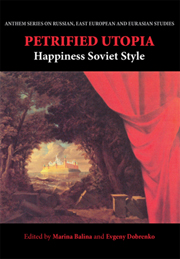Book contents
- Frontmatter
- Contents
- List of Illustrations
- Acknowledgments
- List of Contributors
- Introduction
- Petrified Utopia
- Part One Utopics
- Part Two Realities
- 5 ‘It's Grand to be An Orphan!’: Crafting Happy Citizens in Soviet Children's Literature of the 1920s
- 6 Sew Yourself Soviet: The Pleasures of Textile in the Machine Age
- 7 Happy Housewarming!: Moving into Khrushchev-Era Apartments
- 8 When We Were Happy: Remembering Soviet Holidays
- Part Three Locations
- Notes
- Index
6 - Sew Yourself Soviet: The Pleasures of Textile in the Machine Age
from Part Two - Realities
Published online by Cambridge University Press: 05 March 2012
- Frontmatter
- Contents
- List of Illustrations
- Acknowledgments
- List of Contributors
- Introduction
- Petrified Utopia
- Part One Utopics
- Part Two Realities
- 5 ‘It's Grand to be An Orphan!’: Crafting Happy Citizens in Soviet Children's Literature of the 1920s
- 6 Sew Yourself Soviet: The Pleasures of Textile in the Machine Age
- 7 Happy Housewarming!: Moving into Khrushchev-Era Apartments
- 8 When We Were Happy: Remembering Soviet Holidays
- Part Three Locations
- Notes
- Index
Summary
Tissue, textile and fabric provide excellent models of knowledge, excellent quasi-abstract objects, primal varieties: the world is a mass of laundry.
— Michel Serres, ‘Les Voiles,’ in Les cinq sens.In April of 1930, the women's magazine Zhenskii zhurnal (Women's Journal) offered its resourceful reader instructions on how to make a ‘panneau’, or wall decoration. (Fig. 6.1) This sumptuous object was to be achieved by appliqué design on plain fabric, ‘basic cotton, hessian or canvas’. The reader of Zhenskii zhurnal—like that of other women's magazines of the time such as Rabotnitsa (Working Woman) and Iskusstvo odevat'sia (The Art of Dressing)—was, it is to be presumed, skilled in appliqué, for articles introducing and developing the technique and applying it to the production of all manner of useful household objects were common in editions of such magazines from the mid-1920s on.
Appliqué was just one aspect of the category known as rukodelie (literally, a thing made with one's hands), which appeared increasingly prominently in the female press. From 1926 until the early 1930s, each issue of Zhenskii zhurnal contained a one-page section with the heading ‘Rukodelie’ and instructions on how to make objects for the home. In 1930, the heading was changed to the more portentous ‘Remeslo i prikladnoe iskusstvo’ (Craft and Applied Arts), but the content remained essentially unchanged.
- Type
- Chapter
- Information
- Petrified UtopiaHappiness Soviet Style, pp. 115 - 132Publisher: Anthem PressPrint publication year: 2009
- 3
- Cited by

